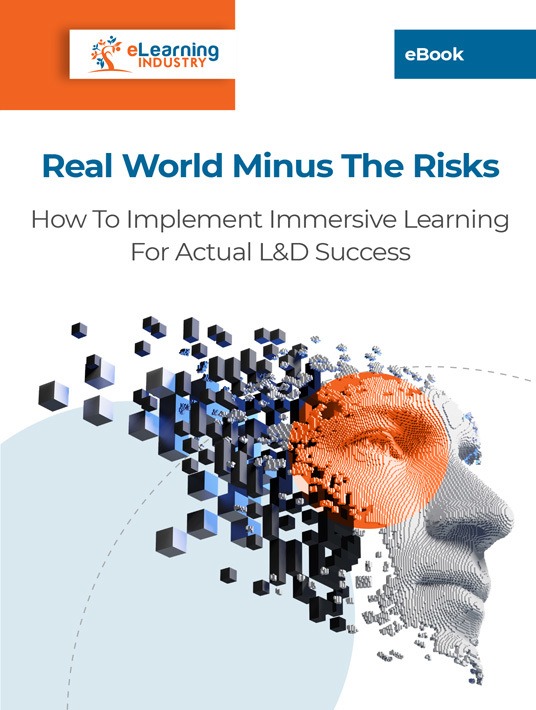Facilitate Calculated Risk-Taking On The Job
Some decisions don’t pan out. They turn into mistakes that might be embarrassing at first but eventually lead to personal growth. However, these errors also impact co-workers, customers, and your company’s profit margin. So, how do you enable employees to take calculated risks and explore the cause and effect that comes with them? Immersive learning invites them to take the leap after careful planning, evaluation, and historical analysis. As such, they make fewer mistakes in the workplace because they know the repercussions involved. But they’re also able to seize opportunities thanks to higher self-confidence and insights. Here are 7 ways to use immersive learning to encourage calculated risk-taking.

1. Serious Games With Real-World Obstacles
The most significant risks are often associated with problems. We encounter an obstacle and must determine the right approach. Sometimes we achieve the desired outcomes while others result in catastrophic failure—at least on a personal level. Serious games can help employees evaluate their responses to stressful situations. Then they see if the risk is worth taking and how their choices or behaviors impact the outcome. For example, they choose to offer the client an add-on or complementary product even though they said they were only interested in one item. Does the customer walk away because they feel pressured into a sale? Or does the employee end up with higher ticket sales? Consider hiring VR training companies if you lack the necessary eLearning tools or know-how.
2. Simulations With Follow-Up Evaluation
Simulations are one of the most effective immersive learning risk-taking tools because they mimic real-world situations. Employees must exhibit certain behaviors and apply skills to achieve the online training objective. Which risks are worth taking and what do the employees learn from every missed opportunity? The secret is to follow up with personal evaluation so that employee training participants know how to improve and where they went wrong. Encourage them to reflect on their actions and habits. Is there a way they can speed up the task without making mistakes? Ask them to highlight the major risks they took during the simulation and the reasoning behind it. How did they calculate all the possible outcomes and why did they choose that specific approach?
3. Branching Scenarios With Integrated eLearning Feedback
Branching scenarios include decision paths and outcomes. So, they’re ideal for calculated risk-taking because employees can see how every choice has negative or positive consequences, as well as how one simple mistake has far-reaching effects on your organization. Incorporate eLearning feedback based on their performance, missteps, and skill gaps. For example, they need to improve their communication skills to boost service scores and avoid irate customers the next time around.
4. Storytelling With Valuable Work Lessons
Stories are another immersive learning activity that is lower-tech but still engaging and interactive. You can also include visual elements to enhance immersion and improve knowledge retention as well as build that crucial emotional connection. For instance, the anecdote explores a sexual harassment issue and how the narrator witnessed an incident between two co-workers. How did they react? Did they follow the reporting protocols? What did they learn from the experience? Include images, video clips, and audio to put them in the middle of the story. Lastly, recap the risks involved and how to mitigate them on the job.
5. Demo Videos With Interactive Quizzes
Create demo videos for product knowledge, compliance issues, and complicated tasks so that employees can see how it’s done. Then follow up with a simulation or serious game that tests their understanding and risk-taking abilities. Let’s use the example of a health and safety online training demo. The simulation that comes after gauges their safe handling know-how. Should they risk handling the product without the suitable gear? Should they use machinery? What happens if they drop the item and need to enact containment protocols?
6. Group Collabs With Brainstorming Built-In
Tech advancements allow you to create virtual training spaces where everyone gathers remotely. Employees are represented by avatars and you can even customize the online locale to make it reflect your brand image. Give employee training participants the chance to collaborate with peers to solve common problems and brainstorm all the possible outcomes. Encourage them to backtrack how each risk impacted the situation and what they would do differently and why. They’re able to discuss their decision-making process and how they came to the conclusion. As well as receive guidance from more experienced peers who’ve dealt with similar situations on the job.
7. AR Tutorials With Embedded Online Training Resources
AR training tutorials keep corporate learners grounded in the real world but still offer valuable risk-taking opportunities. Map out all the steps involved or the behaviors they must exhibit. Then embed the online training resources they need to fine-tune core competencies. AR technology allows them to interact with virtual objects to see how their actions impact the world around them. For instance, they watch the online training tutorial to learn how to identify customer needs and buying behaviors. Then they access an embedded simulation that gauges their level of proficiency. Do they choose the wrong product for a customer and miss out on a sale? Are they able to read the nonverbal cues to determine if risk-taking is the right option?
Risks are nothing to fear provided they are calculated and carried out in a safe space. Namely, a virtual training environment where employees learn from mistakes without hurting the company’s bottom line. Or putting others in harm’s way. Employee training participants take risks to see where they lead and determine the best course of action. Not every choice leads to success, but it does bring them one step closer to fulfilling their potential and mastering newfound skills.
A Mixed Reality training strategy doesn’t have to drain your organization’s resources or make you go over budget. Download the eBook Real World Minus The Risks: How To Implement Immersive Learning For Actual L&D Success, and discover how you can benefit from incorporating immersive learning into your online training program. Provide an engaging training experience and boost your employees’ confidence with a Mixed Reality training solution.









